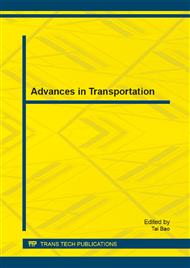p.666
p.671
p.675
p.683
p.689
p.698
p.703
p.712
p.719
Study on the K-Shortest Paths Searching Algorithm of Urban Mass Transit Network Based on the Network Characteristics
Abstract:
K-shortest path is of great significance for urban rail mass transit operation and management especially in large-scale network. The paper has analyzed composite structure characteristics and proposed the route features of the network. According to the former analyses, the author put forward a new method to build a double-layer network model based on the train operation with the corresponding double-layer searching algorithm to solve the model in order to obtain the k-shortest paths. Finally, the rationality and effectiveness of the algorithm had been verified through the examples, which prove that it could provide a new method to get the optimal k-shortest path between different O-D pairs in large scale network, and the search efficiency could be increased more than 13%. As a path searching algorithm based on the train running timetable, it demonstrate decision support for the operation of urban rail mass transit.
Info:
Periodical:
Pages:
689-697
Citation:
Online since:
January 2014
Authors:
Keywords:
Price:
Сopyright:
© 2014 Trans Tech Publications Ltd. All Rights Reserved
Share:
Citation:


